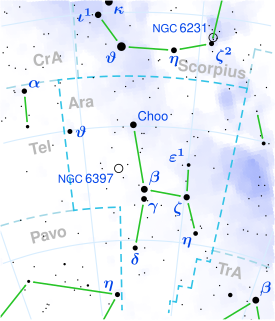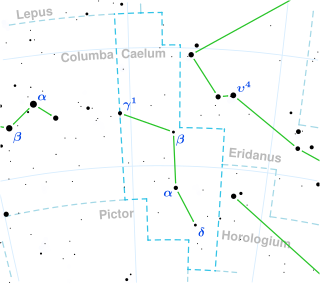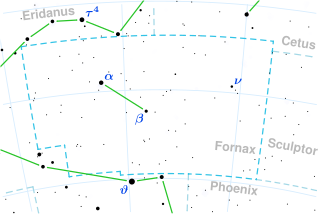HD 169830 is a star in the southern constellation of Sagittarius. It has a yellow-white hue and is dimly visible to the naked eye with an apparent visual magnitude of +5.90. The star is located at a distance of 120 light years from the Sun based on parallax. It is drifting closer with a radial velocity of −17.3 km/s, and is predicted to come as close as 20.7 ly (6.4 pc) in 2.08 million years. HD 169830 is known to be orbited by two large Jupiter-like exoplanets.
HD 210277 is a single star in the equatorial constellation of Aquarius. It has an apparent visual magnitude of 6.54, which makes it a challenge to view with the naked eye, but it is easily visible in binoculars. The star is located at a distance of 69.5 light years from the Sun based on parallax, but is drifting closer with a radial velocity of −20.9 km/s.

Eta Apodis, Latinized from η Apodis, is a star in the southern circumpolar constellation Apus. Based upon parallax measurements from the Hipparcos mission, it is approximately 141 light-years from Earth. With an apparent visual magnitude of +4.9, it can be viewed with the naked eye from the southern hemisphere.

Tau2 Aquarii, Latinized from τ2 Aquarii, is the Bayer designation for a single star in the equatorial constellation of Aquarius. It is visible to the naked eye with an apparent visual magnitude of +4.0. Because the star lies near the ecliptic it is subject to occultations by the Moon. The star is located at a distance of approximately 318 light years from the Sun based on parallax.

Zeta Arae is the third-brightest star in the southern constellation Ara. The apparent visual magnitude of this star is 3.1, which can be seen from suburban skies in the southern hemisphere. From the parallax measurements, it is located at a distance of 490 light-years from Earth.

106 Aquarii, abbreviated 106 Aqr, is a single star in the equatorial constellation of Aquarius. 106 Aquarii is the Flamsteed designation, and it also bears the Bayer designation i1 Aquarii. It has an apparent visual magnitude of +5.2, making it bright enough to be viewed from the suburbs according to the Bortle Dark-Sky Scale. An annual parallax shift of 8.61 milliarcseconds yields an estimated distance of around 380 light-years from Earth.

Nu Caeli is a yellow-white hued star in the constellation Caelum. It has an apparent visual magnitude of 6.07, which indicates it is near the lower limit on brightness that is visible to the naked eye. According to the Bortle scale, the star can be viewed from dark suburban skies. Based upon an annual parallax shift of 20.3 mas as seen from Earth, this star is located 161 light years from the Sun.

V337 Carinae is a K-type bright giant star in the constellation of Carina. It is an irregular variable and has an apparent visual magnitude which varies between 3.36 and 3.44.
HD 80230 is a single star in the southern constellation of Carina, near the northern constellation border with Vela. It has the Bayer designation g Carinae, while HD 80230 is the star's identifier in the Henry Draper catalogue. This is a suspected variable star with a brightness that has been measured varying from magnitude 4.31 down to 4.35, both of which is bright enough for the star to be visible to the naked eye. The distance to this object is approximately 490 light years based on parallax, but it is drifting closer to the Sun with a radial velocity of −5 km/s.
HD 17092 is a star in the constellation of Perseus. It has an orange hue but is visible only with binoculars or better equipment, having an apparent visual magnitude of 7.73. The distance to this star is approximately 750 light years from the Sun based on parallax, and is drifting further away with a radial velocity of +5.5 km/s.
HD 222582 is a multiple star system in the equatorial constellation of Aquarius. It is invisible to the naked eye with an apparent visual magnitude of 7.7, but can be viewed with binoculars or a small telescope. The system is located at a distance of 138 light years from the Sun based on parallax, and it is drifting further away with a radial velocity of +12 km/s. It is located close enough to the ecliptic that it is subject to lunar occultations.
HD 213240 is a possible binary star system in the constellation Grus. It has an apparent visual magnitude of 6.81, which lies below the limit of visibility for normal human sight. The system is located at a distance of 133.5 light years from the Sun based on parallax. The primary has an absolute magnitude of 3.77.
HD 60532 is a white (F-type) main sequence star located approximately 84 light-years away in the constellation of Puppis, taking its primary name from its Henry Draper Catalogue designation. It is calculated to be 1.44 times more massive than the Sun. The star is only 59% as old as our Sun and has metallicity of only 38% that of our Sun. In 2008, two extrasolar planets were discovered in orbit around it.
HD 145377 is a star in the southern constellation Scorpius. It has an apparent visual magnitude of 8.10 and can be viewed with a small telescope. The star is located at a distance of 175 light years from the Sun based on parallax, and it is drifting further away with a radial velocity of +11.6. The absolute magnitude of this star is 4.31, indicating it would be visible to the naked eye if it were at a distance of 10 parsecs.
HD 189276 is a single star in the northern constellation Cygnus, positioned near the northern constellation border with Draco. It has an orange hue and is faintly visible to the naked eye with an apparent visual magnitude of 4.98. The star is located at a distance of approximately 820 light years from the Sun based on parallax, and it has an absolute magnitude of −2.25. It is drifting further away with a radial velocity of +4 km/s. The star has a high peculiar velocity of 38.5+1.8
−2.2 km/s and thus is a probable runaway star.
HD 102350 is a single star in the constellation Centaurus. It has a yellow hue and is visible to the naked eye with an apparent visual magnitude of 4.11. The distance to this star is approximately 390 light years based on parallax, but it is drifting closer with a radial velocity of −3 km/s. It has an absolute magnitude of −1.51.

Sigma Ophiuchi, Latinized from σ Ophiuchi, is a single, orange-hued star in the equatorial constellation Ophiuchus. Its apparent visual magnitude is 4.31, which is bright enough to be faintly visible to the naked eye. The annual parallax shift of 3.62 mas as seen from Earth provides a distance estimate of roughly 900 light years. It is moving closer to the Sun with a radial velocity of −28 km/s.

λ1 Fornacis, Latinized as Lambda1 Fornacis, is a red giant star in the southern constellation of Fornax. It is just visible to the naked eye as a dim, yellow-hued point of light with an apparent visual magnitude of 5.91. The star is located 383 light years from the Sun, based on stellar parallax, and is drifting further away with a radial velocity of +10 km/s.
HD 76270, also known as HR 3544, is a solitary star located around 2,000 light years away from Earth based on parallax.

CD-73°375 is a binary star located in the constellation Volans about 820 light years away. The two components, HR 2979 and HR 2980, are separated by two arc-seconds. The pair has a combined apparent magnitude of 6.34. It has a radial velocity of about 13 km/s, which means it drifting away from the Solar System.









